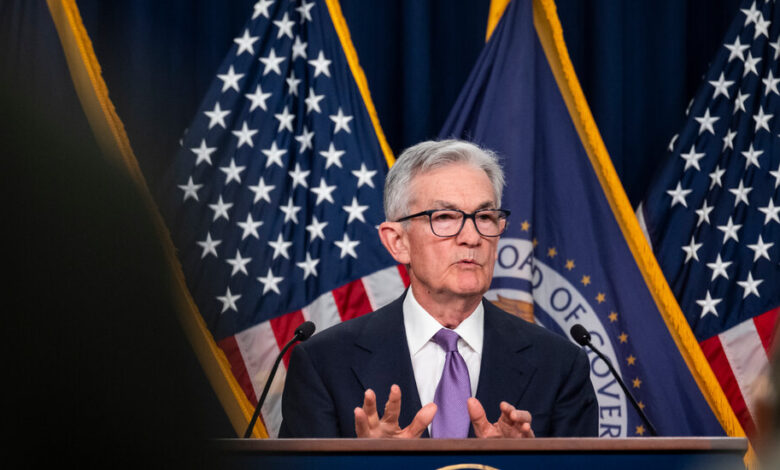What to Watch as the Fed Makes Its Interest Rate Decision

Federal Reserve officials will conclude their two-day policy meeting on Wednesday afternoon, and while central bankers are widely expected to leave interest rates unchanged, there is an unusual degree of uncertainty about what exactly they will signal about the future.
On the one hand, officials could stick with their recent script: Their next policy move is likely to be an interest rate reduction, but incoming inflation and growth data will determine how soon reductions can begin and how extensive they will be.
But some economists are wondering if the central bank could pivot away from that message, opening the door to the possibility that its next rate move will be an increase rather than a cut. Inflation has proved alarmingly stubborn in recent months and the economy has retained substantial momentum, which could prod officials to question whether their current 5.33 percent rate setting is high enough to weigh on consumer and business borrowing and slow the economy. Policymakers believe that they need to use interest rates to tap the brakes on demand and bring inflation fully under control.
The Fed will release its policy decision in a statement at 2 p.m. Eastern. But investors are likely to focus most intently on a news conference scheduled for 2:30 p.m. with Jerome H. Powell, the Fed chair. Central bankers will not release quarterly economic projections at this gathering — the next set is scheduled for release after the Fed’s June 11-12 meeting.
Here’s what to watch on Wednesday.
The Key Question: How Hawkish?
The key question going into this meeting is how much central bankers are likely to change their tone in response to stubborn inflation.
After three full months of limited progress on lowering inflation, some economists see a small chance that the Fed could signal that it’s open to considering raising interest rates again — a message that Fed watchers would consider “hawkish.” But many think that the Fed will stick with its current message that rates are likely to simply remain set to the current relatively high rate for a longer period of time.
“I doubt that the Fed is going to change their bias any time soon,” said Subadra Rajappa, head of U.S. rates strategy at Société Générale. “I think they probably just wait for higher interest rates to feed through the economy.”
One reason that it might be premature for the Fed to shift their message? While inflation progress has recently stalled, many economists expect price increases to begin to cool again in the months ahead, partly because they expect a key rent measure to slow.
Investors still see little chance that the Fed will have raised rates by the end of the year, and they think its most likely that the central bank will cut rates once or twice by December, based on market pricing. But they now see about a one in four chance that officials will not move borrowing costs at all this year. That uncertainty over what the Fed might do next is also clear in economist forecasts.
Goldman Sachs predicts reductions in July and November, but said that “even moderate upside surprises” to inflation “could delay cuts further.” BNP Paribas this week changed its forecast to a first cut in December, on the basis July was too soon for the Fed to feel confident that inflation is under control and September is too close to the presidential election (while the Fed is independent of politics, some forecasters think that officials will want to avoid jumping into the headlines and the fray so close to the vote).
It’s Unclear How Much Rates Are Hurting.
Mr. Powell is likely to face questions on Wednesday about just how much interest rates are actually weighing on the economy.
Fed officials stopped raising interest rates at the current level because they believed it was high enough to substantially tap the brakes on growth. Officials have now held rates steady at a more than two-decade high since July. Those rates make it expensive to borrow to buy a house or car or to expand a business, so they are typically expected to slow consumption, investment and hiring.
But the economy has held up unexpectedly well in the face of elevated borrowing costs. Hiring has remained rapid, consumer spending is still chugging along, and although the latest gross domestic product report was a bit slower, the economy has generally been expanding at a solid clip. That has caused some analysts to question whether rates are as restrictive as expected.
If rates aren’t squeezing the economy as much as policymakers had anticipated, it could mean that they have to leave interest rates at a high level for longer to slow the economy enough to wrestle down inflation. Or more drastically, it could prod some Fed officials to begin to call for higher rates.
Up until recently, Fed officials have embraced the economy’s surprising resilience because it came alongside cooling inflation. But now that inflation is hitting a roadblock, that confidence could crack.
That said, policymakers can still point to reasons for the strong growth — ones that are not necessarily inflationary. That is especially true in the labor market, where worker supply has improved as people re-enter the job search and amid strong immigration that appears to be continuing into 2024.
That has allowed employers to hire without having to compete so fiercely for workers that they need to rapidly raise wages, and pay gains have remained strong but have cooled from their boiling-hot levels last year.
“Through a prepandemic lens, the economy looks quite strong, maybe even hot right now,” said Ernie Tedeschi, a research scholar at Yale Law School who was until this spring a White House economic adviser. But given all of the gains to labor supply, “maybe we shouldn’t use a prepandemic lens for thinking about the economy right now.”
Markets Will Care About the Balance Sheet.
Investors have been on edge as they anticipate a longer period of high interest rates. The S&P 500 fell about 4 percent during April, its worst showing since September. But Wall Street is also watching another key development: What comes next with the Fed’s balance sheet.
While the Fed’s main policy tool is interest rates, officials also bought bonds in mass quantities in 2020 during the pandemic to soothe troubled markets and to stimulate the economy. They are now shrinking those bond holdings by allowing securities to mature without reinvesting. Policymakers have signaled that they are poised to slow that process soon.
Some economists think that the change could come at this meeting, while others think policymakers are more likely to wait until their June gathering to announce their plans.
When the Fed shrunk its balance sheet before the pandemic, it allowed the process to go too far, roiling markets in mid-2019. That volatile period makes the balance sheet a point of focus for many investors.



